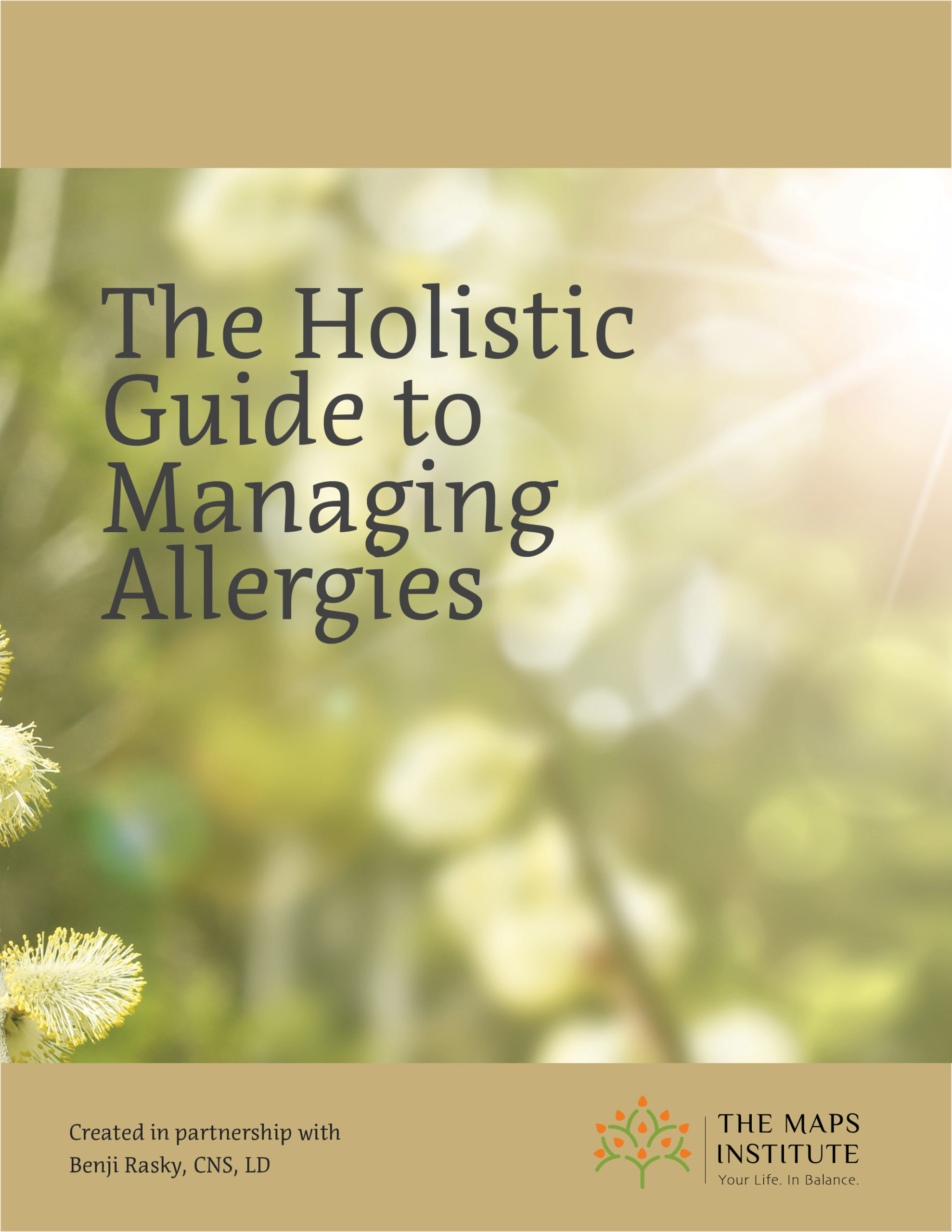Spring is finally here! And it’s about time after what basically feels like a year-long winter. Humans everywhere are rejoicing its arrival —for about a week, that is, until we realize that our delicate bodies seem to react to even the smallest, mostly harmless invisible proteins in the environment.

Welcome to allergy season!
Allergies, however, are more than a mere inconvenience to be handled by popping some pill — despite what some pharmaceutical companies might have you believe.
I first started sneezing my head off on the day I graduated high school. The proof of this unwelcomed development is pristinely captured in my graduation pictures! I was immediately started on Zyrtec, which quickly became a daily regimen along with nasal corticosteroids (Flonase) and Mucinex with Sudafed.
Like most allergy sufferers, I didn’t think much of this pharmaceutical barrage. I just wanted to breathe and get some allergy relief.
But my allergies kept getting worse, and I started experiencing side effects from my daily medication cocktail, including insomnia, migraines, and panic from the Sudafed (I had no idea it was not meant to be taken daily or that it’s an AMPHETAMINE).
It was this experience that ultimately led me to explore the true nature of allergies and my interest in natural medicine.
Get The Holistic Guide to Managing Allergies — for FREE!
Learn the 5 strategies that can help you manage your allergies holistically and understand the role that air quality, diet, nutrients, herbs, and nutraceuticals can play as you create your own allergy relief plan.

Our Serious and Growing Allergy Problem
Allergies, also known as allergic diseases, are a variety of conditions caused by hypersensitivity of the immune system to typically harmless substances in the environment. These diseases include hay fever, food allergies, atopic dermatitis, allergic asthma, and anaphylaxis. Symptoms may include red eyes, an itchy rash, sneezing, a runny nose, shortness of breath, or swelling. Allergic rhinitis, asthma, and atopic eczema are among the most common chronic illnesses.
Moreover, these diseases are increasing in prevalence with as much as 40% of humans now suffering from some form of allergies. As a result, these chronic, but often overlooked diseases add a considerable burden to healthcare systems around the world.
Allergic rhinitis alone is estimated to affect 10 to 30 % of the world’s population with 11.1 million visits to physician offices in 2010 to address it. In the United States, 1 in 10 adults, and 1 in 13 children have at least one food allergy. 200,000 people each year require emergency medical care for allergic reactions to food.
But while this is a serious medical challenge, it isn’t just an issue of burdens on our healthcare systems.
Allergies have a significant negative impact on the sufferer’s quality of life with scores that are comparable to those of living with diabetes and other chronic illnesses.
The real question we need to be asking, therefore, is why the dramatic rise in allergic related diseases, and how can you combat them more effectively?
The Western Lifestyle is Exacerbating Allergic Reactions — and Making Allergy Relief Harder
Allergies are twenty times more common in affluent, ‘westernized’ countries compared with countries with low average incomes.This explosion in allergic diseases in recent years cannot be explained by genetic differences alone.
The hygeine hypothesis has been the most prominent model used by scientists to try to understand these occurrences. It asserts that living conditions in much of the so-called western world might be too sterile and that, as a result, kids aren’t being exposed to germs that would otherwise train their immune systems to distinguish between harmless and harmful irritants.
There is now good evidence for this theory.
For instance, Amish children—- who grow up on traditional farms with close contact to livestock — are six times less likely to develop asthma and atopy than Hutterite children, whose communities have adopted large-scale industrial farming practices.
However, new evidence suggests that this is not as simple as just giving everyone adequate exposure to farm animals. The western lifestyle is characterized by a number of factors that may be contributing, including:
- An estimated 90% of our time spent indoors
- Decreased physical activity
- A highly processed diet
- Chronic stress
- Diminishing family and social connections
All of these factors have been linked to poor metabolic and immune resilience.
Spending more time indoors in well-insulated houses, for instance, increases exposure to indoor allergens such a mites and cockroaches, indoor pollutants such as fine particulates, smoke and cooking fumes, mold, volatile organic compounds (VOCs) from building materials, and household chemicals.
According to the EPA the levels of indoor air pollutants are often two to five times higher than outdoor levels, and in some cases these levels can exceed one hundred times that of outdoor levels of the same pollutants — meaning that sometimes the air inside can be more harmful than outside.
The composition and diversity of the microbiome in the gut and skin are influenced by all these changes in living environment, diet, and lifestyle. As a result, some are even proposing that the hygiene hypothesis be updated to the “old friends” or biodiversity hypothesis as they observe that the increase in allergies is due to the loss of symbiotic relationships with parasites and bacteria that were once beneficial to our evolution.
Indeed, numerous studies have shown that young children at risk of developing allergies have gut microbiome dysbiosis, in which particular strains are lacking while others, such as Clostridia species, are over-represented. These imbalances in the gut, skin, and nose are associated with eczema, asthma and food allergy.
Why, exactly, a western lifestyle reduces microbiome diversity in newborns remains an area of intense research, but there is evidence that the mode of infant feeding, dietary diversity and fiber content for both mother and child, mode of childbirth, sibling order in a family, and presence of pets and/or farm animals during childhood all have strong effects.
What it all comes down to is that microbial balance and diversity are health-promoting, while imbalance can lead to inappropriate inflammatory responses — which leads us back to the challenge of finding allergy relief.

Great, but Why am I Sneezing?
To understand how to manage allergic disease, we need to step inside the castle walls. Stay with me.
Mammals have an incredibly sophisticated and endlessly complicated immune system forged in the entangled evolution of trillions of viruses, bacteria, fungi, and protozoa. As amazing as it is, however, our body’s defenses are a bit outdated and confused when facing the modern environment shaped by human intervention.
This is a complicated topic, so allow me to explain it using the example of a medieval castle.
Our first line of defense is the physical barriers, the stone structure of the castle, towers, battlements, and heavy castle doors. These are our skin, which is impenetrable unless destroyed, and mucous membranes which are more selectively permeable.
The threat of invasion is constant, so our castle has a full-time military defense system known as our immune system. Within it, there are different branches and specialized units that serve different functions, although they wear similar uniforms! There are guards at every entrance and on top of every tower and wall (our innate immune cells), and a group of highly trained warriors waiting in the wings (our adaptive cells).
However, if our front-line defenses have not been adequately trained to skillfully discern and take down a foreign invader, they do their best to deal with the threat, and also send a messenger (an antigen-presenting cell) to the elite training camps inside the castle (lymph nodes) with a fragment of the invader to see if any of the trained warriors (T cells) know how to handle it.
If one is adequately matched, it proudly stands, armors up, and rushes to the site of the breach. This signals the wizards (B cells) to start producing specialized threat detectors (antibodies) to distribute to the sentinels (mast cells and basophils) on the front lines throughout the entire castle. These sentinels are armed to the teeth (with histamine and other inflammatory mediators), and now they are on high alert for this specific enemy.
The next time these invaders attack, the sentinels deploy everything in their arsenal and immediately sound the alarm for reinforcements to eliminate the perceived threat.
We experience this as swelling, redness, itching, excessive mucous, sneezing, difficulty breathing, and in the most extreme cases, anaphylaxis.
This process is what is happening inside of you when you have an allergic reaction.
An Alternative Approach to Finding Allergy Relief
The understanding I just shared with you is the result of years of study in an attempt to overcome my own challenges and find allergy relief.
With this knowledge, and years of experimentation, I found that I could use the knowledge of my internal castle and it’s protective system to manage my body’s reaction while limiting or eliminating the use of pharmaceuticals. Ultimately, I eliminated dairy and started taking a combination of quercetin and stinging nettle, which enabled me to cut my medication intake dramatically while enjoying similar allergy relief.
As my understanding of the immune system grew, it further opened the door to a more effective protocol to prevent and relieve symptoms while working on treating the root cause.
The end result of this study and experimentation has led me to develop a comprehensive guide and protocol that I’m excited to share with you. It’s called The Holistic Guide to Managing Allergies, and you can download it here for free.
Get The Holistic Guide to Managing Allergies — for FREE!
Learn the 5 strategies that can help you manage your allergies holistically and understand the role that air quality, diet, nutrients, herbs, and nutraceuticals can play as you create your own allergy relief plan.

While the guide is by no means an exhaustive or exclusive list of ways to address allergies, it includes those strategies, nutrients, herbs, and nutraceuticals that have the most evidence of their effectiveness, are most readily available, and which I have found most useful, both personally and clinically.
It’s also important to note that while all of these therapies have been found to be very safe, they still have contraindications and interactions with medications, and the guide is not intended as a replacement for consulting with your medical team. Instead, you should use this guide as a tool to explore holistic approaches to dealing with your allergies and to discover what works for you so that you can find allergy relief and enjoy next Spring without worry!
Image credits: Lukasz Szmigiel and Benji Rasky.

Life-long allergy sufferer, here! This article was super interesting, insightful, and helpful!
I never had allergies before five years ago. This is the worst time of year for it.